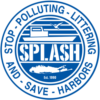July 1, 2010 by Kara Jackson · Leave a Comment
When describing local SCUBA diving, former commercial diver Rob Weltner likens it to an underwater battle scene. “There are life and death struggles between a fluke and a crab, blackfish and barnacles, and you see the whole scene play out in front of you. I had a squadron of striped bass pass in front of me once. They were like a V formation underwater. There were 15 or 16 of them. One would bust out of the pack and get something to eat and kind of fall back into place.”
Yet despite the inter-species acrimony, all of these creatures have a common foe: trash. This adversary strikes from the land and air and also, the sea. From floating fishing lines to toxic chemical compounds, these enemies are not just unpleasant to look at: they are deadly. One of the worst offenders is those ubiquitous white plastic bags which, when floating in the water, “look just like squid.” Explains Weltner: “Everything feeds on squid: whales, tuna, sea turtles.”
“What we are doing affects everything under water – all the pollution, all the atmospheric deposition lands on the bottom of the bays. I’ve seen pods of balloons floating around a hundred miles off shore. I wish people would make that connection: what goes up must come down and what comes down lands in the ocean.”
That’s why Weltner and the organization he presides over, Operation SPLASH (Stop Polluting Littering And Save Harbors), are picking up as much debris as they can while making people aware of the problem. The goal of this Nassau County-based volunteer group, Weltner says, is “to get garbage before it becomes a killer.”
Weltner warns that garbage including cigarette butts, chemicals, road run-off, plastic bottles and more land trash ends up in storm drains, making up 95% of the marine debris. Though some may see that as only a problem, Operation SPLASH also viewed it as an opportunity, purchasing specialized fiberglass filters to catch the debris in the storm drains all along Freeport’s Nautical Mile (the results have been outstanding, with far less floating flotsam today).
Even when you don’t see bobbing trash, that doesn’t mean it isn’t a threat. A lot of submerged or invisible pollutants go undetected. “Unless you are down under the water and see the destruction under there, you don’t really appreciate or see what’s going on,” notes Weltner.
To make others aware of the garbage battles waged below, Weltner and his trash-busting team recently produced video documentaries of the benthic (underwater) environment. Starting in Montauk, the crew filmed what itshould look like on the sea bottom. Moving further west, the videos showed a different portrayal altogether –what the bottom does look like as the clarity and condition of the water changes dramatically for the worse. Though the videos are not yet publicly available, the Operation SPLASH website http://operationsplash.org is a good source of information about how what lands in the water can wind up in our food and in our bodies.
“Our goal,” Weltner chuckles, “is to put ourselves out of business.”









